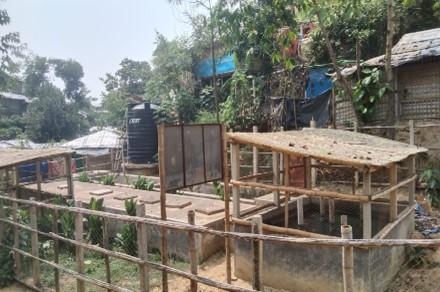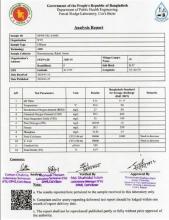Anaerobic Baffled Reactor
Organisation that implemented the case study
Description of the emergency context
Currently, there are 929,606 Rohingya refugees residing in 33 congested camps that have been officially designated by the Government of Bangladesh. This population surge occurred as a result of the extreme violence outbreak in Myanmar's Rakhine State on August 25, 2017, which led to an estimated 687,000 Rohingya refugees crossing the border into Cox's Bazar, Bangladesh. The Rohingya refugees have repeatedly sought refuge in Bangladesh due to ongoing persecution. Previous significant influxes occurred following acts of violence in Rakhine State in 1978, 1992, 2012, and once again in 2016. However, the largest and most rapid refugee influx from Myanmar into Bangladesh began in August 2017.
Operating within highly congested settings, such as the Rohingya camps, WASH actors face numerous challenges in implementing effective faecal sludge treatment processes that can efficiently remove pathogens. These challenges primarily stem from space limitations, which impose constraints on the inclusion of appropriate, safe, and sustainable processes for treatment.
Description of the treatment process
Storage Tank:
The sludge from toilets is empitied into the transfer points which are connected to FSTP from different drections using motorized equipments like super sucker or centry focal pump. The dumping chamber has capacity of 10000 Ltr. These points are situated in high elivation in order to transfar the sludge to settler tanks using gravity follow.
Settler Tank:
Solid and liquid seperation occurs at settler tanks and the liquid enters the baffled reactors for next level of treatment.
Anaerobic Baffled Reactor:
ABR consists of a tank and alternating hanging and standing baffles that compartmentalisethe reactors and force liquid to flow up and down from one compartment to the next, enabling an enhanced contact between the fresh wastewater entering thr reactors and the residual sludge, containing the microorganisms responsible for anaerobic digestion of the organic pollutants.
Gravel Filter Bed:
It contains stone, sand and canna Indica(Kolaboti) plants with a capacity of 55m3. Microbal treatment in the effluent forms gelatin, while plant roots reduce pathogenic organisms, At the end of the filtration waste water pass through a coarse land layer and moves to polishing pond before final discharge to environment.
Polishing Pond:
The stored water in the polishing pond comes direct contact with sunlight and some pathogens are removed. Pond water is taken for lab testing of indicators like BOD, COD, TSS, FC, TDS. Finally treated waste water disclosed to the environment if the results are satisfactory.
Sludge Drying Bed:
The drying bed is situated adjecent to the settler and ABR tanks. When solid portion of sludge occupies 50% of tank volume, it is transferred to the drying bed where it transforms to soil like substance and also helminths are removed.
Assessment & design (feasibility)
The total cost for implementing the ABR system is USD 13,600, which covers all the necessary materials, such as Bricks, sand, Cement, stone chips, PVC pipes,GI Net and fencing. It also includes the construction work, such as site preparation, digging infiltration trenches and sludge pits, and installing hardware materials for the tank. All the materials used in this system are locally sourced and readily available worldwide.
FS characteristics: values where obtained from the WASH cluster
During the site identification stage of the project, it is crucial to find a suitable location considering the challenging and crowded nature of the camps. Several key parameters need to be taken into account during the assessment.
Population: The targeted population should be considered, keeping in mind that each system can serve a maximum of 5720 users.
Latrine Covarage: 225 doors
Surface area: Approximately 235 m2 of land is required for the totla Treatment.
Soil infiltration rate: Testing and calculation of the soil's infiltration rate is necessary for each site.
Groundwater levels: Here the aviodable.
Flood-prone areas: It is imperative to avoid locating the system in flood-prone areas.
Proximity to water sources: Infiltration trenches should be at least 30 meters away from the nearest water point.
Construction
Pre construction:
- For construction this facilities at first need to check topography level.
- Do need assesment.
- Then do FDG's with beneficaries/communities about this.
-Besides, need to ready design & BOQ then need to submit this WASH sector.
- After, need to site visit with focule person s likes: govt employee/CiC/SMS/SD.
- There have also checked nearest water source distance.
-Maintain to keep good environment.After all kinds of verification need to start work.
During Construction:
- After selection vendor, need to do layout to the field by direction from design.
-All kinds of materilas need to be quality checked.
- Ensure, all construction support materilas likes: mixer machine,vibrator machine,water.
- During the construction maintain curing.
-During construction we ensure sfatety eqipment likes sorrounding area fenching/ marking cution tape and other eqipments.
-All workers maintained safety helmet,gumboat,hand goolves( mask also-during crusial time).
-Ensure all kinds of quality control likes custing & brick working time.
-During construction time, maintain MB book/ daily work record book.
-Ensure proper construction ratio where its needed.
-We ha ve follow govt worker law.
-Don't engage here children workers.
-For daily materilas received & stock maintain ensur a guard for this.
After Construction:
- After construction work we do all work component checked as per design & BOQ.
- We ensure completed work monitoring by our management and doner level authority.
- All work accepted by EIC
- After work we do vendor billing process
Operation and maintenance
ABR Performance Summary:
Parameters tested between inlet and outlet show significant reduction, demonstrating the effectiveness of the treatment mechanism:
COD: 99.5mg/l (Bangladesh Standard 200mg/l) / COD Reduction: 98%
BOD: 27mg/l (Bangladesh Standard 30mg/l) / BOD Reduction: 98%
TN: 140mg/l (Bangladesh Standard 15mg/l)
pH: 8.31 (Bangladesh Standard 6-9)
TSS: 52mg/l (Bangladesh Standard 100mg/l)
TC: 90000CFU/100ml ((Bangladesh Standard 1000CFU/100ml)
Desludging and O&M:
- 1 daily desludging team required (10m3 per day).
- Use 01 desludging pumps in series:
- Regular monitoring by trained staff is essential for preventive maintenance.
-Monitor the filling process. Be prepared to shut it down in case of broken pipe or separated coupling.
-Workers must be resposible for wearing eye protection and other PPE, especially when mixing lime to form the slurry.
-Periodically cutting the grass on the embarkments.
-Repair any type of damage to fence and gates.
-Removal of any materials blocking the chambers inlets and outlets.
-Application of sludge, desludging, control of drainage systems and of the secondary treatment for percolate or dried sludge. Desludging everyone to several weeks.
-Sludge treatment sites should have facilities for hand washing and bathing, agencies should have provided soap.
Lessons learned
-Public health friendly procedure operated which better than LSP.
-Community provide positive feedback that its not spreading bad smell.
-BOD and COD demand results come rapid and correct.
Strengths
-Strong Resistance.
-Built from local Materials.
-Biogas can be recovered.
-No electrical energy is required.
-Low operating costs.
-High Reduction of BOD.
-Long service life.
-Moderate Area requirements(can be built underground)
Weaknesses
-Long start up phase
-Requires expert design and construction.
-low reduction of pathogens and nutrients.
-Effluent and sludge requires further treatment.
-Clear design guidelines are not available yet.
-Needs strategy for fecal sludge management(effluent quality rapidly deteriorates if sludge is not removed regularly).


Add new comment